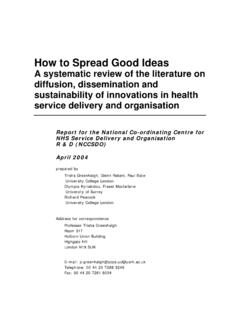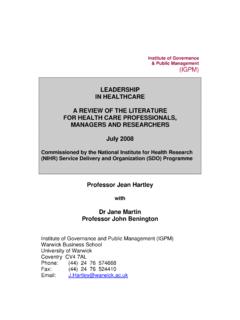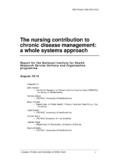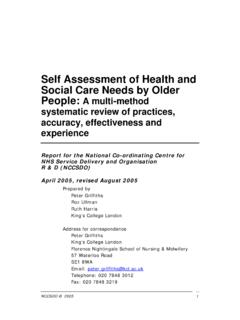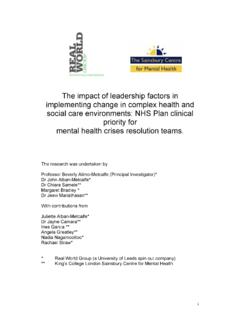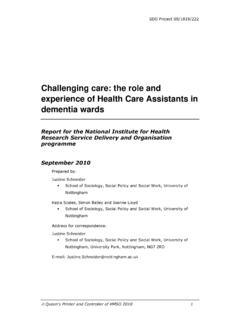Transcription of Transition from CAMHS to Adult Mental Health Services ...
1 SDO Project 08/1613/117). Transition from CAMHS to Adult Mental Health Services ( track ): A study of Service Organisation, Policies, Process and User and Carer Perspectives Report for the National Institute for Health Research Service Delivery and Organisation programme January 2010. prepared by Professor Swaran P Singh Health Sciences Research Institute, University of Warwick Dr Moli Paul Health Sciences Research Institute, University of Warwick Dr Zoebia Islam Health Sciences Research Institute, University of Warwick Dr Tim Weaver Division of Neurosciences and Mental Health , Imperial College London Queen's Printer and Controller of HMSO 2010 Page 1. SDO Project 08/1613/117). Dr Tami Kramer Division of Neurosciences and Mental Health , Imperial College London Professor Susan McLaren Faculty of Health and Social Care, London South Bank University Dr Ruth Belling Faculty of Health and Social Care, London South Bank University Dr Tamsin Ford Child Health , Peninsula College of Medicine and Dentistry Ms Sarah White Division of Mental Health , St.
2 George's, University of London Ms Kimberly Hovish Division of Mental Health , St. George's, University of London Ms Kath Harley Division of Mental Health , St. George's, University of London track Project Steering Committee members: Jenny Dale, Dr Navina Evans, Nicole Fung, Dr Dan Hayes, Dr Bob Jezzard, Dr Anne Rourke, Dr Morris Zwi Address for correspondence Professor Swaran P Singh Health Sciences Research Institute Warwick Medical School Gibbett Hill Campus University of Warwick Coventry CV4 7AL. E-mail: Queen's Printer and Controller of HMSO 2010 Page 2. SDO Project 08/1613/117). Contents 3. Acknowledgements .. 6. 1 7. Background: review of literature ..8. The importance of Transition .. 8. The definitions of Transition : adolescence to adulthood ..10. Transition in Health Transition from child and adolescent Mental Health Services ( CAMHS ) to Adult Mental Health Services (AHMS) ..14. Barriers to optimal Transition ..19.
3 Transition from CAHMS to AMHS: gaps in the evidence base ..21. track study : aims & 2 Stage 1: Audit of Transition Protocols .. 24. Aims 24. Methodology ..24. Data Results ..28. London West Midland site (Coventry & Warwickshire only) ..28. Structure of protocol-sharing units ..28. Transition boundary ..35. Transition protocols ..35. Discussion ..39. 3 Stage 2: Case note survey of transitions .. 43. Aims 44. Definitions ..44. Data collection tools ..45. Case Phase 1: accessing databases ..46. Phase 2: contacting clinicians ..46. Developing the TRACKING Data Statistical analysis ..48. Reliability of data extraction ..48. Transition pathways ..48. Predictors of achieving Predictors of achieving an optimal Transition ..50. Results ..50. Case Queen's Printer and Controller of HMSO 2010 Page 3. SDO Project 08/1613/117). pathways ..52. of achieving transitions: cases ..66. transitions: predictors of experiencing continuity of care.
4 70. Discussion ..76. Identifying actual and potential referrals ..76. Sample Transition pathways ..80. Predictors for achieving Transition from CAMHS to AMHS: actual v potential Optimal or suboptimal Transition ..84. Predictors of experiencing continuity of care ..85. 4 Stage 3: Organisational perspectives of Health and social care professionals and representatives of voluntary organisations .. 87. Aims 88. Design and Methods ..88. Diagnostic Semi-structured Results ..91. Resources ..92. Eligibility issues .. 102. Communication and working practices .. 107. Service cultures .. 116. Discussion .. 120. Transition : informational continuity .. 120. Transition : cross boundary and team 121. Transition : flexible and long-term continuity .. 123. Transition : relational, personal and therapeutic continuity124. 125. 5 Stage 4: Case studies .. 128. Aims 129. 129. Sampling 129. Recruitment of the sample .. 129. Interview method .. 130.
5 Data management and analysis .. 130. Results .. 134. Characteristics of the sample .. 134. Preparation for Transition .. 134. Accounts of Transition .. 138. The outcome of 143. Other factors impacting on Transition process and outcome .. 146. Respondent-generated suggestions for improvement in Transition .. 151. Discussion .. 152. Issues and limitations .. 152. Transition experiences of service users, carers and Mental Health professionals .. 154. 6 156. Queen's Printer and Controller of HMSO 2010 Page 4. SDO Project 08/1613/117). Introduction .. 157. Context of Transition : service complexity and cultures .. 161. Service complexity .. 161. Service cultures .. 162. Negotiating the Transition 163. Policies and protocols .. 163. Eligibility criteria .. 164. 166. Crossing the Transition boundary: optimal and suboptimal 167. Joint 167. Information transfer .. 168. Therapeutic relationships and family involvement .. 169. 170.
6 7 172. Introduction: mind the gap .. 173. Improving the CAMHS /AMHS interface: mind how you cross the gap 173. Developing a youth Mental Health service: bridging the gap .. 180. References .. 183. Appendix 1: Mapping Tool .. 194. Appendix 2: Case note tracking questionnaire for actual 202. Appendix 3: Case note tracking questionnaire for potential referrals .. 222. Appendix 4: Stage 3 interview 237. Appendix 5: Stage 4 interview schedule for service users .. 239. Appendix 6: Stage 4 interview schedule for parents243. Appendix 7: Stage 4 interview schedule for CAMHS . clinicians .. 247. Appendix 8: Stage 4 interview schedule for AMHS. clinicians .. 250. Queen's Printer and Controller of HMSO 2010 Page 5. SDO Project 08/1613/117). Acknowledgements The track study group gratefully acknowledges the help, input and cooperation of clinicians, managers and administrative staff from the six study sites. We are also very thankful to all the service users and carers who gave their time and invaluable contribution for the qualitative interviews in study four.
7 Queen's Printer and Controller of HMSO 2010 Page 6. SDO Project 08/1613/117). The Report 1 Introduction Adolescence represents an inner emotional upheaval, a struggle between the eternal human wish to cling to the past and the equally powerful wish to get on with the future. Louise J. Kaplan, psychoanalyst and author What I was really hanging around for, I was trying to feel some kind of a good- by. I mean I've left schools and places I didn't even know I was leaving them. I. hate that. I don't care if it's a sad good-by or a bad good-by, but when I leave a place I like to know I'm leaving it. If you don't, you feel even worse. Salinger, The Catcher in the Rye Queen's Printer and Controller of HMSO 2010 Page 7. SDO Project 08/1613/117). Background: review of literature The importance of Transition There has been long standing concern about young people with Mental Health problems who fall between child and adolescent Mental Health Services ( CAMHS ) and Adult Mental Health service (AMHS) and may get lost' during their move from CAMHS to AMHS (hereby called Transition ).
8 (Royal College of Paediatrics and Child Health , 2003; Lamb, Hall, Kelvin and Van Beinum, 2008, p6). Disruption of care during Transition adversely affects the Health , wellbeing and potential of this vulnerable group (American Academy of Pediatrics, American Academy of Family Physicians and American College of Physicians-American Society of Internal Medicine, 2002; Forbes, While, Ullman, Lewis, Mathes and Griffiths, 2002; While, Forbes, Ullman, Lewis, Mathes and Griffiths, 2004; Department of Health , 2006c; Kennedy, Sloman, Douglass and Sawyer, 2007; Department for Children Schools and Families and Department of Health , 2008; Lamb et al, 2008). Ideally, such a Transition should be a planned, orderly and purposeful process of change from child-oriented to Adult models of care (Blum, Garell, Hodgman, Jorissen, Okinow, Orr and Slap, 1993; McDonagh and Kelly, 2003). Transition is distinct from transfer: the latter refers to termination of care by a children's Health care provider which is re-established with an Adult provider (Burke, Spoerri, Price, Cardosi and Flanagan, 2008).
9 Transition is more than merely the means of an individual moving from one service to the next, but instead is a way to enable and support a young person to move towards and onto a new life stage' (Beresford, 2004, p584). It is a multidimensional, multidisciplinary, lengthy process continuing on into Adult care, marked by joint responsibilities in multidisciplinary working (Royal College of Nursing, 2003; Royal College of Paediatrics and Child Health , 2003; HASCAS, 2006; McDonagh and Viner, 2006). It therefore needs to be co-ordinated, planned, efficient and smooth' (Conway, 1998, p210). As a dynamic process with a beginning, middle and end' (McDonagh, 2006, p3), optimal Transition to Adult Health care should support each young person in attaining his or her maximum potential' (Rosen, 2004, p125). Young people undergoing Transition are also negotiating a developmental Transition from childhood to adulthood, which generates needs beyond those which are illness-specific (Royal College of Paediatrics and Child Health , 2003; Royal College of Nursing, 2004).
10 Needs related to such developmental Transition may remain unmet if the process is seen simply as an administrative event between CAMHS and AMHS (Vostanis, 2005). Transitional care is becoming an important focus for both policy and practice with calls for generic, cross-specialty developments, since many problems which arise at the interface are not specialty- or disorder-specific, but embody common challenges for child and Adult Services across specialities (McDonagh and Viner, 2006). Queen's Printer and Controller of HMSO 2010 Page 8. SDO Project 08/1613/117). In the USA, a survey of Transition provision within 41 states found that a quarter of child Mental Health Services and half of Adult Services offered no Transition support (Davis, Geller and Hunt, 2006). Another US study (Davis and Sondheimer, 2005) found that continuity of care was hampered by separate child and Adult Mental Health systems, marked by separate policies for access, lack of clarity in access procedures and lack of shared planning.
